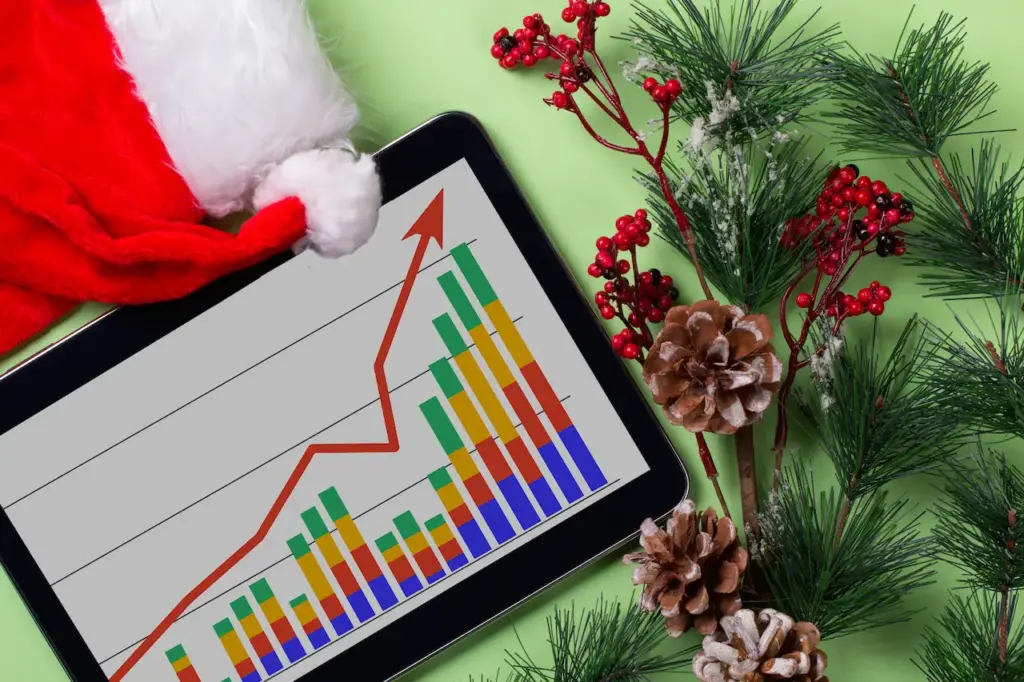Christmas Spending Statistics
Christmas Spending Statistics & Trends Australia (2022): 18 Keys
Aussies have started to prepare for Christmas! Over 9 million Australians are expected to buy gifts for their friends and families, spending approximately 24 billion dollars. This equates to an estimated average of USD 1,160 per person.
WhatASleep commissioned a study to better understand the Christmas spending habits of 500 Australians. The respondents were asked to share their plans for budgeting and giving gifts during the holiday season. The study includes data from reliable sources and past surveys.

The key Christmas spending statistics
- This is higher than the $1,012 spent last year primarily due to inflation. The $1,012 that was spent last year is now higher due to inflation.
- In total, Australians will spend 24 billion dollars over the festive season. This is up 3% compared to last year.
- Due to inflation and rising prices, one-fifth (20%) of Australians are expected to spend less in the coming year.
- Two-fourths of Australians will likely make purchases for their holiday on a mobile device.
- It is expected that 22% of Australian consumers will incur holiday debt.
- Gifts are the most expensive Christmas expense, with an estimated $680 per person. Next is Travel at $220, and then food and alcohol at $190.
- Parents in Australia plan to spend an average of $289 per child on Christmas.
- 71% will use their savings for their Christmas purchases. 22% will use credit cards, and the remaining (7%) will use the buy now, pay later service.
- Australians will receive 4.4 billion dollars in unwanted Christmas gifts.
- The average Australian spent 14 hours shopping to buy Christmas presents and bought gifts for nine people.
- Australians spend on average $71 per gift.
- Gift cards are expected by 40% of recipients this year.
- Gift vouchers and gift cards are the most popular (51%), followed by board games and puzzles (20%), money (15%), and electronics (9%).
- The hospitality industry (socialising and restaurants, holidays etc.) The Christmas season is expected to be a boom in spending, with an estimated $9 billion spent. This represents a 16% increase from last year.
- Cyber week will account for 25% of holiday spending, with 84% of Australians completing their shopping one week before Christmas.
- New South Wales is the state with the highest average Christmas spending, at $1,345 per individual. Western Australians, on the other hand, are the least extravagant, only spending $920 per individual.
Australian Christmas spending trends for 2022
1. What do Australians expect to spend on Christmas?
The Christmas season is rapidly approaching and so will the inevitable shopping spree. According to a 2022 forecast by the Australian Consumer, they will spend an average of $1,150 for Christmas gifts, travel expenses, food and other holiday expenses. This represents a 9% rise from the $1.012 spent in the previous year. The main reason for this is the increasing prices of goods.
Aussies will spend $24 billion over the holiday season. This is up 3% on last year. The average Aussie spends $71 on nine gifts for friends, family and co-workers.
2. Average holiday spending per state
New South Wales (NSW), with an average holiday spend of $1,345 for each person, leads the nation. Victoria ($1,310), Queensland (£1,225), South Australia and Western Australia ($920) are the next highest spenders.
The NSW shoppers are expected to spend $7.4 Billion this Christmas. Victorians will likely spend $6.7 Billion, Queenslanders $4.70 billion, and South Australians 2 billion.
3. Mobile devices are expected to be used by 46% of consumers for holiday shopping.
Australians tend to shop in stores, but the pandemic forced many of them to change. Mobile commerce has seen a rise in popularity. 46% of consumers prefer to purchase holiday gifts on their phones.
Compared to last year there has been a 60% increase in mobile shopping and a 30% decrease in in-store shopping.
4. Australians shop hybrid, with a similar share of mobile and in-store shopping.
According to the Inmobi study, 46% are likely to use mobile phones this holiday season. 42% will shop in stores, and 12% will use desktop websites.
Compared to the previous year, 60% more people are shopping via mobile. 30% fewer people are shopping in stores. Mobile commerce reflects the global trend that has seen an increase in mobile shopping as a result of the pandemic.
5. Due to the rising cost of living, one-fifth (25%) of Australians will reduce their Christmas expenditure.
Many Australian families are feeling the pinch. 20% of Australians say they will spend less on Christmas this year due to inflation. One-third (33%) of Australians say they will spend more on the holiday season while 47% plan to keep spending the same.
6. In Australia, 24% of all retail sales are made during the holiday season.
Retail spending in Australia will reach $64 billion, an increase of 3% over last year. Holiday sales account for 24% of the annual revenue of retailers.
7. The top Christmas expenditure is gifts, which account for 58% of your holiday budget.
The average Australian spends $680 or 58% on Christmas gifts. The next biggest expense is travel (19%). Food and drink (16%), and non-gift items (five %).
Category-wise spending:
- Gifts: $680 (59%)
- Travel: $220 (19%)
- Food & Alcohol: $190 (16%)
- Non-gift items: $60 (5%)
Australians are not dampened by the inflationary climate, as their holiday spending is expected to rise by 3% compared to last year.
WhatASleep commissioned a study to better understand the Christmas spending habits of 500 Australians. The respondents were asked to share their plans for budgeting and giving gifts during the holiday season. The study includes data from reliable sources and past surveys.

The Key Christmas Spending Statistics
- This is higher than the $1,012 spent last year primarily due to inflation. The $1,012 that was spent last year is now higher due to inflation ..
- In total, Australians will spend 24 billion dollars over the festive season. This is up 3% compared to last year.
- Due to inflation and rising prices, one-fifth (20%) of Australians are expected to spend less in the coming year.
- Two-fourths of Australians will likely make purchases for their holiday on mobile.
- It is expected that 22% of Australian consumers will incur holiday debt.
- Gifts are the most expensive Christmas expense, with an estimated $680 per person. Next is Travel at $220 and then food and alcohol at $190.
- Parents in Australia plan to spend an average of $289 per child on Christmas.
- 71% will use their savings for their Christmas purchases. 22% will swipe a credit card and the remaining (7%) will use the buy now, pay later service.
- Australians will receive 4.4 billion dollars in unwanted Christmas gifts.
- The average Australian spent 14 hours shopping to buy Christmas presents and bought gifts for nine people.
- Australians spend on average $71 per gift.
- Gift cards are expected by 40% of recipients this year.
- Gift vouchers and gift cards are the most popular (51%), followed by board games and puzzles (20%), money (15%) and electronic (9%).
- The hospitality industry (socialising and restaurants, holidays etc.) The Christmas season is expected to be a boom in spending, with an estimated $9 billion spent. This represents a 16% increase from last year.
- Cyber week will account for 25% of holiday spending, with 84% of Australians completing their shopping one week before Christmas.
- New South Wales is the state with the highest average Christmas spending, at $1,345 per individual. Western Australians, on the other hand, are the least extravagant, only spending $920 per person.
Australian Christmas spending trends for 2022
1. What do Australians Expect to Spend on Christmas?
The Christmas season is rapidly approaching and so will the inevitable shopping spree. According to a 2022 forecast by the Australian Consumer, they will spend an average of $1,150 for Christmas gifts, travel expenses, food and other holiday expenses. This represents a 9% rise from the $1.012 spent in the previous year. The main reason for this is the increasing prices of goods.
Aussies will spend $24 billion over the holiday season. This is up 3% on last year. The average Aussie spends $71 on nine gifts for friends, family and co-workers.
2. Average Holiday Spending Per State
New South Wales (NSW), with an average holiday spend of $1,345 for each person, leads the nation. Victoria ($1,310), Queensland (£1,225), South Australia and Western Australia ($920) are the next highest spenders.
The NSW shoppers are expected to spend $7.4 Billion this Christmas. Victorians will likely spend $6.7 Billion, Queenslanders $4.70 billion and South Australians 2 billion.
3. Mobile Devices are Expected to be Used by 46% of Consumers for Holiday Shopping.
Australians tend to shop in stores, but the pandemic forced many of them to change. Mobile commerce has seen a rise in popularity. 46% of consumers prefer to purchase holiday gifts on their phones.
Compared to last year there has been a 60% increase in mobile shopping and a 30% decrease in in-store shopping.
4. Australians Shop Hybrid, with an Equal Share of Mobile and in-store Shopping.
According to the Inmobi study, this holiday season, 46% are expected to use their phone, 42% to shop in stores, and 12% to use desktop websites.
Compared to the previous year, 60% more people are shopping via mobile. 30% fewer people are shopping in stores. Mobile commerce is a reflection of the global trend that has seen an increase in mobile shopping as a result of the pandemic.
5. Due to the Rising Cost of Living, One-Fifth (25%) of Australians will Reduce their Christmas Expenditure.
Many Australian families are feeling the pinch. 20% of Australians say they will spend less on Christmas this year due to inflation and rising costs of living. One-third (33%) of Australians say they will spend more on the holiday season while 47% plan to keep spending the same.
6. In Australia, 24% of all retail sales are made during the holiday season.
In the run-up to Christmas, Australians will spend over $64 billion on retail goods. This is up 3% compared to last year. Holiday sales account for 24% of the annual revenue of retailers.
7. The Top Christmas Expenditure is Gifts, Which Account for 58% of your Holiday Budget.
The average Australian spends $680 or 58% on Christmas gifts. The next biggest expense is travel, followed by food and drinks (16%) and other non-gift items (five %).).
Category-wise spending:
- Gifts: $680 (59%)
- Travel: $220 (19%)
- Food & Alcohol: $190 (16%)
- Non-gift items: $60 (5%)
8. When it comes to spending on holidays, millennials are the most generous.
Millennials (aged 26-41), according to research, are the most likely to spend $1,350 on average this holiday season. Gen Xers (aged between 42 and 56) are next, with an average of $1,235. Gen Zers (aged between 17 and 25) are expected to be the third largest spenders, with an average of $1,020. Baby Boomers (aged over 56) are expected to be the most frugal at $800.
9. Gift cards are Australia’s most popular gift. 40% of Australians hope to receive a card this holiday season.
Gift cards are the most requested gift items. They come in at 40%, followed by clothing, 20%, cash, 19%, experiences, and 9% physical items like tech or homewares.
10. When choosing a present, 54% of Australians consider the price the most important consideration.
More than half of Australians (54%) say that the price is a crucial factor in choosing a gift. The convenience of the gift (18%), and speed of delivery (14%) are also important factors that Aussies consider when selecting gifts for this holiday season.

It is not surprising that most people are looking for bargains and price reductions due to the increasing cost of living and inflation. It’s no wonder that 25% of Australians plan to shop during the Cyber Week sales.
11. Most Australians (71%) use their savings to pay for their holidays.
Families in Australia are using their savings to pay their Christmas expenses. 71% of them say they will use this money. Australians have a higher percentage of savings than Americans. Only 64% said they’d use their savings. One-fifth of Australians use credit cards to pay for their holiday expenses.
22% of Australians will pay for their holiday debt primarily on credit cards. 7% of Aussies will use BNPL like Afterpay this year, up 34% on last year.
12. Prices of consumer goods have risen 6.8% in the last year.
Australia, like other countries, is also facing record levels of inflation. Prices of consumer goods are up 6.8% compared to last year. Fruits and vegetables have increased by 18.60%. The rising costs are a concern for many Australians but they don’t stop them from shopping during the holidays. Only 20% of Australians responded to the survey by saying they would be reducing their holiday budget.
13. This holiday season, women are more likely than men to spend 39% on gifts.
According to the survey, women will likely spend 39% higher on gifts this holiday season compared to men. Women are expected to spend an average of $730 per gift, compared to men’s $520.
14. Three-quarters of Australians intend to complete their holiday shopping before September.
Australians have a head-start on holiday shopping, with a third (32%) saying that they will finish by the end of October. Unexpectedly, 35% have completed their holiday shopping by October. Many Australians want to avoid the last-minute rush.
29% of respondents plan to shop in November and 6% will do so in December.
15. Gift cards are the most popular choice of gift for Australians.
Gift cards are the gift of choice for Australians when it comes to giving. According to the survey, 51% said that they were planning on giving gift cards during this holiday season. In addition, 40% of respondents also said that they would like to receive gift cards. Board games and toys, cash, and electronic gifts are also popular choices.
16. The recipients of 22% of gifts will not want or need them.
Unwanted or unnecessary gifts can consume a large portion of your holiday budget. In the survey, 22% of respondents stated that they had received unwanted gifts in the past. Clothing and household items are the most unwanted gifts. Books and toys follow.
These unwanted gifts are often thrown out, regifted, or returned. It’s vital to consider your purchase carefully.
Every year, an estimated 4.4 billion dollars is spent on unwanted presents.
17. Holiday spending is expected to have the greatest impact on the hospitality industry.
The hospitality industry is experiencing a revival in the post-pandemic period, as people are spending more on experiences and venturing out. The sector is expected to grow by 16% this holiday season. A total of 9 billion dollars will be spent in the area on dining out, holidays and socializing. The hospitality industry has been hit hard by the pandemic and this is great news.
18. When choosing an online retailer, it is important to look for retailers that offer free or low-cost shipping.
Free or low-cost delivery is the most important factor to Australians when it comes to online shopping. In a Facebook for Business survey, 52% of respondents stated that free shipping is important to them in choosing an online retailer. Sitecore conducted a survey that found Australians are willing to pay $9 for shipping.
The conclusion of the article is:
Christmas is a hectic and expensive season for many Australians. Shoppers are aware of the importance of avoiding overspending, even though they’re getting an early start on holiday shopping. These insights should help you to better manage and understand your holiday spending.